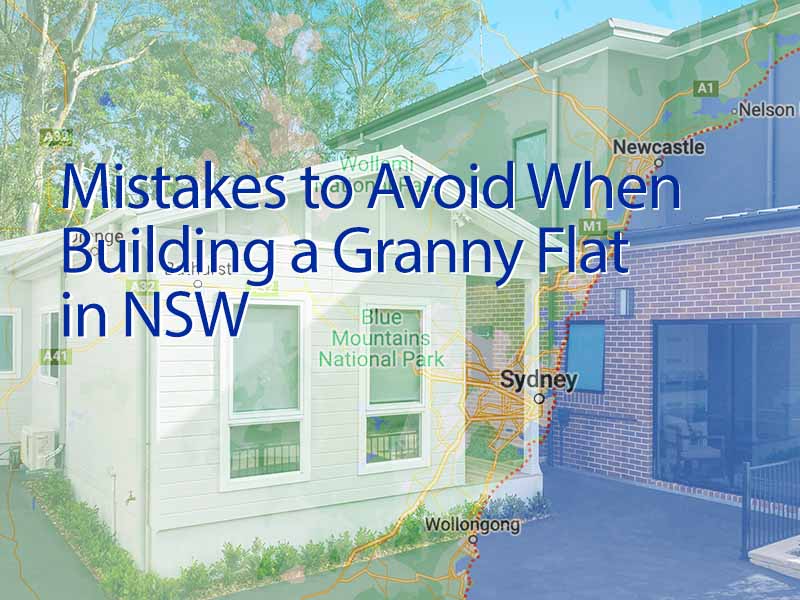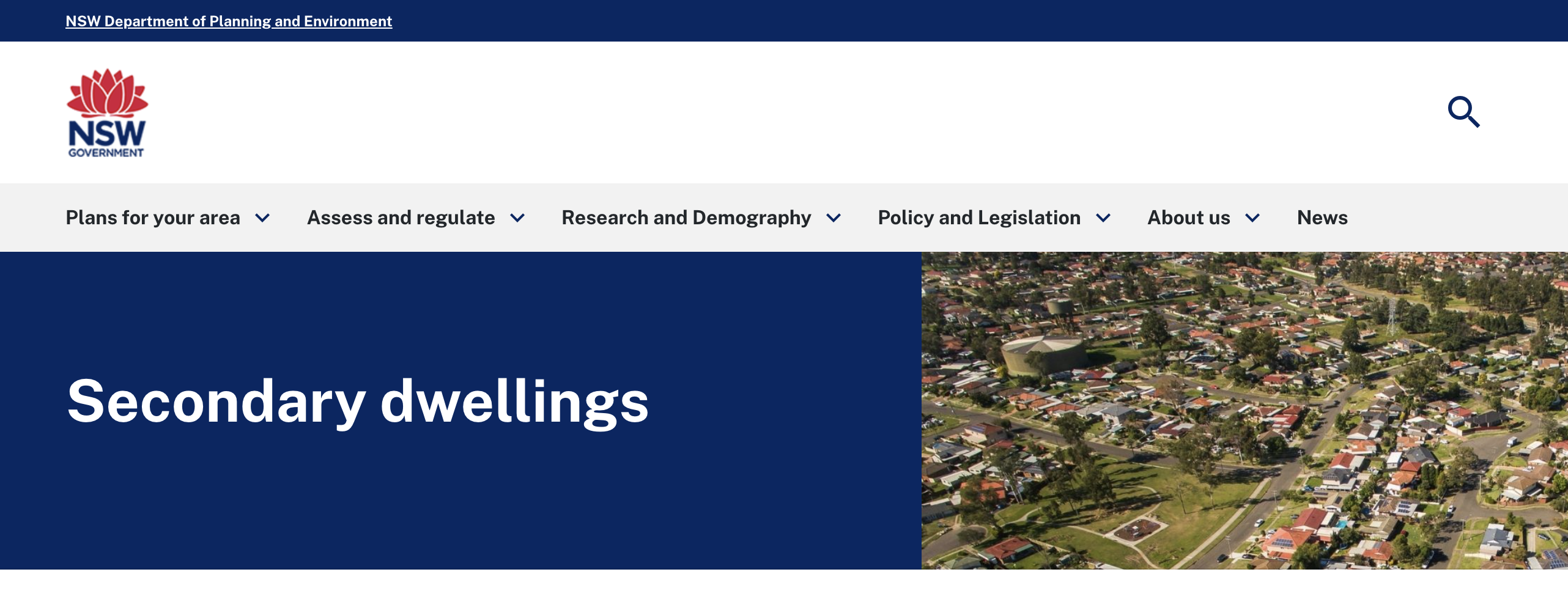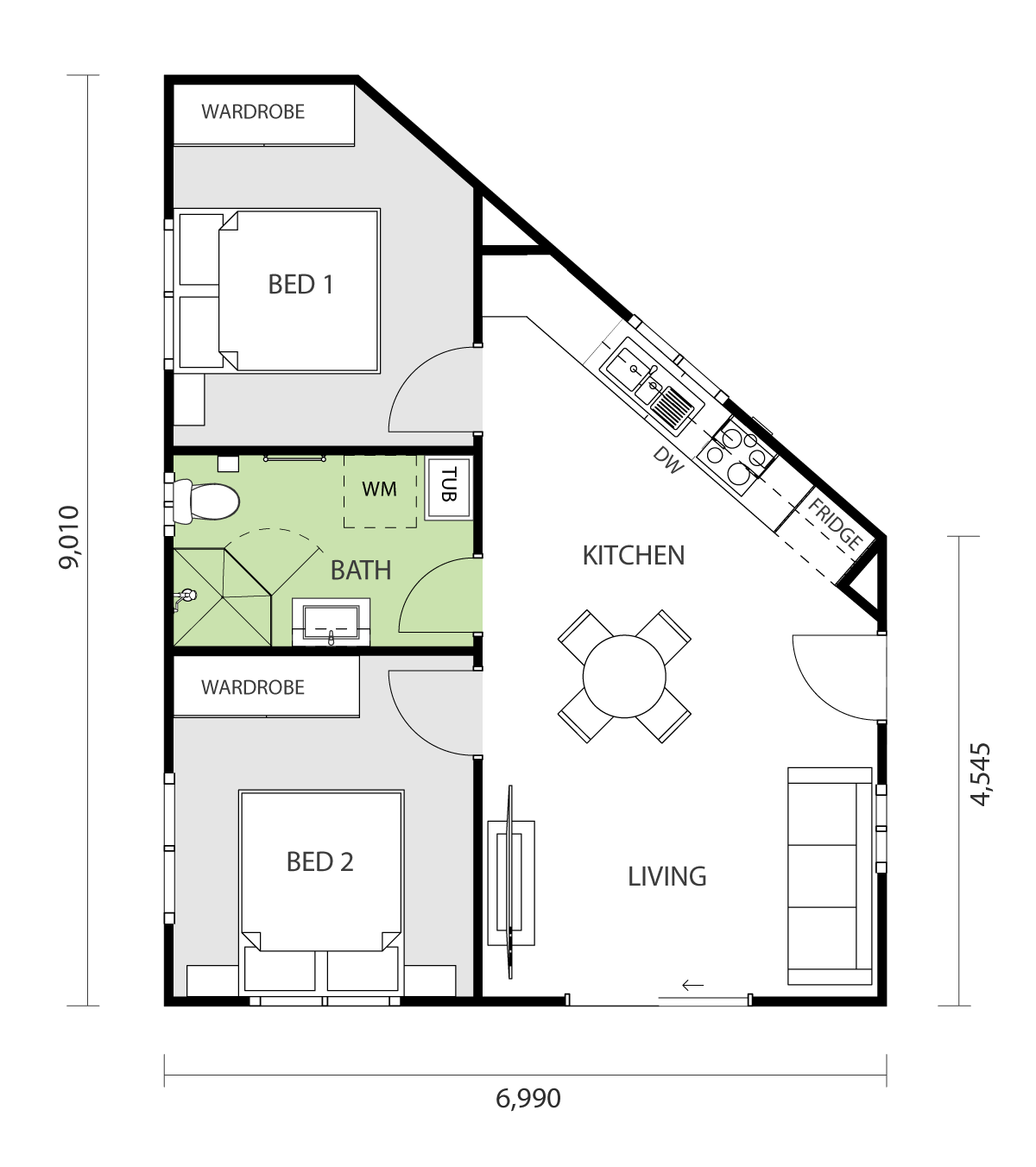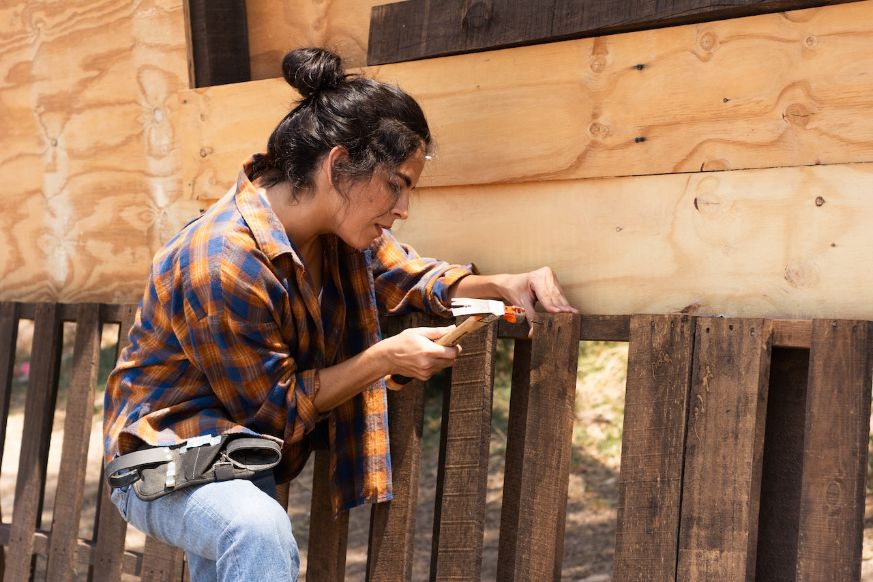7 Common Mistakes to Avoid When Building a Granny Flat in NSW

It’s easier than ever before to build a Granny Flat in NSW, but there are common building mistakes that are easy to make throughout the process.
Here, we’ll review the 7 most common mistakes, why they’ll have a negative impact on your Granny Flat, and how to avoid them for successful project completion.
Key Takeaways
- It’s critical to check the local council regulations and requirements in your area. Obtain the necessary permits and approvals.
- Follow the relevant rules and guidelines throughout your plans to factor in any mobility inclusions for an accessible dwelling.
- Choose a size and design for your Granny Flat that can accommodate its intended purpose and your budget.
- Hire a professional builder and Granny Flat company to adequately prepare the construction site in conjunction with safety standards.
Mistake #1: Not Checking Local NSW Council Regulations

The first mistake many homeowners make is not checking and understanding their local council regulations and requirements. Some may even misunderstand the definition of a Granny Flat and a secondary dwelling.
You’ll have to obtain either a Complying Development Certificate (CDC) or gain council approval through a Development Application (DA).
Each council may have slightly different site requirements, so it’s essential to do your research and work with an experienced Granny Flat builder that can help guide you through the process. The NSW Government lists broad information on its Department of Planning website.
Common consequences of not following Granny Flat council regulations
- Fines: Failure to comply with council regulations when building your Granny Flat can result in hefty fines. These fines can vary depending on the nature of the violation and the local council involved, and they can be very expensive.
- Forced demolition: In some cases, a council may require that a Granny Flat be demolished if it’s found to be in violation of codes or regulations. This can be a costly and disruptive process for homeowners who may have invested significant time and money into building the Granny Flat.
- Legal action: Worst case scenario, homeowners who violate council regulations when building a Granny Flat may face legal action, which can be a stressful and time-consuming process.
Tips for checking local council regulations before building a Granny Flat
- Contact your local council. Contact your local council and enquire about their specific requirements for building a Granny Flat. They’ll provide you with a list of relevant regulations and zoning laws that you must comply with.
- Research online. Many local councils have their building and zoning regulations available online. You can also search for forums or groups where other homeowners in your area have shared their experiences and advice on building Granny Flats.
- Consult a professional. Consider engaging with a professional builder or Granny Flat company who can advise you on the relevant information and help you navigate the approval process.
Mistake #2: Choosing the Wrong Design or Size

Choosing a suitable design and size for your Granny Flat is important for several reasons. It can affect the value of your property, the quality of life for your occupants, and how well the dwelling fulfils its intended purpose.
The local council requirements may also have an impact on the kind of design and size you’re able to use for your Granny Flat, so it’s crucial to have everything thoroughly planned before construction begins.
Common Granny Flat Design Mistakes
- Overlooking natural light and ventilation. Many homeowners forget to consider the importance of natural light and ventilation in their design. Not only can this make an already small space feel cramped and stuffy, but it can also negatively impact the health and wellbeing of the occupants.
- Poor space planning. An inefficient use of space can make the Granny Flat feel cramped and uncomfortable. It’s important to consider the flow of the space, and make sure there’s enough room for necessary furniture and appliances.
- Not considering lifestyle needs. Designing a Granny Flat without careful consideration of your needs or others can result in an impractical and uncomfortable living space. Evaluate the intended use of the Granny Flat and plan the space accordingly.
- Forgetting about storage. A common design mistake in Granny Flats is failing to include adequate storage space. This can lead to a cluttered and disorganised living space, negatively impacting the quality of life for yourself or other occupants.
Tips for Creating a Stunning Granny Flat Design in New South Wales
- Emphasise outdoor living. This will create a sense of spaciousness and provide a relaxing environment for yourself and guests. Consider including a patio, deck, or another type of outdoor seating area that allows for easy access to the backyard.
- Choose high-quality finishes. High-quality finishes, such as durable flooring, quality fixtures, and stylish countertops, can help to create a polished and sophisticated Granny Flat design.
- Use space efficiently. An efficient use of space is key to creating a comfortable and flexible Granny Flat. Consider smart storage solutions, multi-functional areas, and an open floor plan.
- Prioritise natural light. Incorporating natural light and ventilation into your Granny Flat will create a bright, airy, and comfortable living space. Consider large windows, skylights, and other choices that emphasise natural light and fresh air.
Mistake #3: Failing to Budget Properly

Having a realistic budget is crucial; not only will it help you avoid overspending, but it’ll also ensure that you have a clear understanding of the costs involved in the project from start to finish.
You must consider the typical permits, materials, labour costs, and any additional expenses associated with building a Granny Flat. These could include landscaping or connecting utilities. By setting a realistic budget from the outset, you can avoid unexpected costs and keep the project on track financially.
Common Budget Mistakes
- Underestimating costs. Homeowners may not thoroughly research and account for all potential costs, leading to unexpected setbacks and the potential to go over budget.
- Overestimating potential rental income. Some homeowners may overestimate the potential rental income from their Granny Flat, which can result in unrealistic budget expectations.
- Failing to consider ongoing costs. Building a Granny Flat is not a one-off expense. Many homeowners forget to consider ongoing costs such as utilities, insurance, and maintenance and end up with unexpected expenses down the line.
- Choosing low-quality materials. Some people may be tempted to choose low-cost materials to save money, resulting in costly repairs and replacements at a later date.
- Neglecting to plan for contingencies. Many homeowners may neglect to create a contingency fund for unexpected expenses and emergency situations.
Tips for Creating a Realistic Budget for Your Granny Flat
- Research costs. Research the costs associated with building a Granny Flat in your area. This can include labour, materials, permits, and other fees. Use this information to create a realistic budget for your project.
- Prioritise expenses. Prioritise your expenses based on what is most important to you. This may include features such as size, design, materials, or energy efficiency. Allocate your budget accordingly to ensure that you’re able to achieve your Granny Flat goals.
- Plan for contingencies. Plan for contingencies and unexpected expenses when creating your budget. It’s recommended to set aside 10% of your budget for contingencies so you have the funds to cover any unforeseen expenses.
- Get professional advice. Consider consulting with a professional builder, financial advisor, or Granny Flat company to help you create a realistic budget. This will give you a clear idea of the typical costs associated with the construction and design process.
Mistake #4: Not Hiring a Professional Builder

Hiring a professional Granny Flat builder to oversee your project is strongly recommended. They can provide expertise throughout the process, ensuring that everything is completed efficiently and to a high standard.
Not hiring a professional, on the other hand, can lead to several potential issues: poor workmanship, missed deadlines, and costly setbacks. At worst, you may encounter safety hazards and non-compliance with local council regulations.
Mistakes that Occur when Building a Granny Flat Yourself or Hiring an Inexperienced Builder
- Poor workmanship. Lack of experience and training can lead to poor workmanship, resulting in an unsafe and poorly constructed Granny Flat.
- Non-compliance with regulations. Secondary dwellings have certain regulations that must be followed. Failure to comply can result in costly fines, safety hazards, and potential legal consequences.
- Missed deadlines. Poor planning can lead to missed deadlines, causing additional expenses and delays in the construction process.
- Lack of proper insurance. If you’re building the Granny Flat yourself, it’s critical that you have adequate insurance coverage to protect yourself against accidents and property damage in the case of a setback or emergency. Similarly, if you hire an unqualified builder who does not have proper insurance, you may be liable for any accidents or damages that occur during construction.
Tips for Selecting a Reputable Builder located in New South Wales
- Check the builder’s qualifications and credentials. Make sure the builder is properly licensed and insured, and that they have the necessary qualifications and experience.
- Check references. Ask for testimonials from previous customers, pictures of past projects, and reviews of their construction process to get a sense of the builder’s reputation and quality of work.
- Request a detailed quote. Request a detailed quote from the builder that outlines all costs and expenses associated with the project, including any contingencies or potential extras.
- Ask about project management. Ask the builder about their project management process and who will be responsible for overseeing the construction. It’s important to have a clear point of contact and a reliable process in place.
- Review the contract carefully. Carefully review the contract with the builder to ensure that it includes all necessary details, such as payment schedules, warranties, and timelines.
Mistake #5: Neglecting Site Preparation

Site preparation is an essential step in building a Granny Flat in New South Wales. This step will confirm your site is level, stable, and ready for construction. Proper site preparation can also help to prevent issues like drainage problems, soil erosion, and damage to neighbouring properties. Failing to properly prepare can lead to a range of issues, such as water damage.
Common Site Preparation Mistakes in NSW
- Failure to perform a soil test. A soil test is essential to determine the type of soil and the soil’s ability to support the weight of the Granny Flat. Failure to perform a soil test can lead to foundation issues such as sinking or shifting.
- Inadequate drainage. Proper drainage is essential to prevent water damage and soil erosion. Neglecting drainage issues will lead to costly repairs down the line.
- Ignoring property lines. Some homeowners may fail to take street frontage and side boundaries into account, resulting in potential disputes with neighbours and legal issues.
- Poor landscaping. Failure to properly grade the site can lead to drainage issues and soil erosion, while failure to clear the site of debris and other obstructions can result in delays and safety issues.
Tips for Properly Preparing Your Site for Granny Flat Construction
- Address existing structures. If the Granny Flat is being built as an addition to your house or an existing structure, you should address any issues with said structure before construction begins. This may include repairing any damage, upgrading electrical or plumbing systems, or reinforcing the foundation.
- Plan for drainage. Proper drainage is essential for the longevity and safety of any structure. Consider the slope and drainage patterns of the site when preparing for construction and install proper drainage systems. This will help prevent water damage and erosion.
- Clear the land. If there are trees or other vegetation on your lot that will interfere with construction, you’ll have to first clear that section. Similarly, if there are existing structures, such as a shed or a separate garage, they will need to be cleared so the land can be levelled.
- Consider utilities. Ensure that your site has access to all necessary utilities, including electricity, water, and sewer or septic systems offered in your region of NSW. If connections are not available, plan for the necessary upgrades of installations.
Mistake #6: Overlooking Energy Efficiency

An energy-efficient Granny Flat can save you money on your energy bills, reduce your carbon footprint, and provide a more comfortable living space for any occupants. Overlooking energy efficiency, on the other hand, can lead to higher energy bills and a larger carbon footprint.
It’s easy to dismiss in the short term, but investing in energy efficiency will save you a lot of money in the long term.
Common Energy Mistakes to Avoid
- Neglecting insulation. Neglecting insulation, which can reduce heat transfer and energy loss, will lead to significant energy waste and costly bills.
- Installing inefficient appliances. Installing inefficient appliances that consume more energy than necessary lead to higher bills and decreased energy efficiency.
- Ignoring alternative energy sources. Failing to consider alternative sources, such as solar power, will also lead to higher expenses in the long term.
- Not sealing air leaks. Some homeowners may neglect to seal air leaks around windows, doors, and vents, leading to reduced energy efficiency.
Tips to Make Your Granny Flat More Energy Efficient
- Passive solar design. Consider the orientation and layout of your Granny Flat to maximise natural light and heat from the sun.
- Insulation. Use high-quality insulation to reduce heat transfer and energy loss.
- Energy-efficient appliances. Choose modern, energy-efficient appliances such as heaters, air conditioners, and water heaters to reduce your energy consumption.
- Alternative energy sources. Use solar panels or other renewable energy sources to offset the energy consumed by your Granny Flat.
Mistake #7: Ignoring Accessibility Needs

Considering accessibility needs is crucial when designing and building your Granny Flat, as it allows relatives with a disability or limited mobility to live comfortably and independently. Failing to consider accessibility can result in safety hazards, reduced quality of life for occupants, and potentially limit the rental market for your dwelling.
Common accessibility mistakes to avoid
- Lack of space. Failing to provide an adequate floor area for relatives with a disability or mobility issues can make the flat unsuitable for them to manoeuvre comfortably.
- Overlooking mobility inclusions. Some homeowners ignore the need for grab bars, handrails, and other support features, which can increase the risk of falls and injuries for elderly family members.
- Not consulting with experts. Failure to consult with accessibility experts or incorporate their feedback can result in an inadequately accessible Granny Flat, excluding potential occupants and reducing the value of the property.
Tips to make your Granny Flat more accessible
- Non-slip flooring. Use non-slip flooring and materials in the kitchen, bathroom, and other areas to prevent slips and falls for elderly family members.
- Research. Google information on accessibility standards and research your options to ensure that your Granny Flat will meet the needs of any occupants with a disability or mobility issues.
- Consult with an expert. Get in touch with a Granny Flat building expert, who can guide you through the necessary steps to create an inclusive living space.
- Ramps and low thresholds. Install ramps to allow easy access to the Granny Flat for people with mobility tools and wheelchairs. Similarly, low thresholds on doors and shower enclosures will vastly improve their quality of life.
Start Your Granny Flat Building Journey Right
Before the construction of your Granny Flat begins, it’s important to assess all possible risks and considerations throughout the development stage. Communicating with designers, builders, Granny Flat specialists, and other relevant professionals will save you a lot of time, money, and headaches — both in the short term and the long term.
Work With the Best Granny Flat Building Team
If you’re ready to progress to the next stage of your Granny Flat project, or you’re seeking assistance with the planning process, our expert team of Granny Flat builders is here to help. Granny Flat Solutions is a NSW home building company that oversees projects in the Sydney Metro, Illawarra, Central Coast and Newcastle regions.
We offer a free quote and obligation-free site inspection to ensure that all your needs and preferences are met with care, down to the smallest of details. If you have any questions or you’re ready to get started, get in contact with us today!
Ready to start your building journey? Chat to our team of experts today and get a FREE personalised quote
Find Out More
“Experience the difference for yourself.”
Call now to book your obligation free site inspection and quote with our friendly staff.








